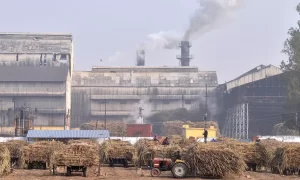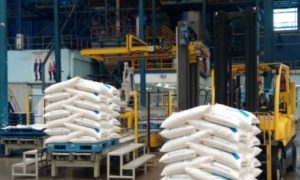Pakistan : Sugarcane — an unviable crop

The Sindh government has delayed setting the sugarcane price for the 2024-25 season, frustrating farmers who face rising production costs. Millers are required to begin crushing by November 21, linked to federal export permissions. Farmers, impacted by political and pricing issues, are increasingly considering alternatives like paddy and wheat, which provide quicker returns than sugarcane.
The Sindh government has yet to notify the sugarcane’s indicative price for the 2024-25 sugarcane crops. Two back-to-back meetings of the Sindh Sugarcane Control Board were held in September and October to discuss the likely rate at which sugar millers, the provincial agriculture department, and farmers pressed their points.
The meeting remained inconclusive, but reports till Nov 7 indicate that close to over a dozen sugar mills are in the process of commencing crushing, though cane procurement has not started. The millers had to commence sugarcane crushing no later than Nov 30 under the 1950 Act, which was amended in 2009 by the Sindh government.
“No, the rate is not yet fixed,” said a Sindh agriculture officer while anticipating that sugar mills would be starting crushing by Nov 21 under the federal government’s decision. This decision, which allowed sugar to be exported by mills, also linked it to the commencement of crushing by this date.
The Economic Coordination Committee (ECC) on Oct 11 allowed the export of 0.5 million tonnes of sugar on request of sugar millers who argued that since they have considerable carryover stocks from last year, export should be allowed. ECC had considered available stock figures shared by the Federal Board of Revenue and the Pakistan Sugar Mills Association had published appeals in newspapers for this purpose, also indicating their inability to start crushing if exports were not allowed.
Frustrated sugarcane farmers lament stalled announcement of price rates and export allowance
A rate of Rs425 per 40kg of sugarcane was fixed for 2023-24 by the Sindh government for the province. The government, in its own assessment, had put the cost of production at Rs475 per 40kg, which was shared by the agriculture department secretary with millers and farmers’ representatives.
“When the Sindh government has come up with a price of Rs475, which was closer to the price assessed by us therefore, we didn’t press for our price of Rs490,” said both Sindh Abadgar Board President Mahmood Nawaz Shah and Sindh Chamber of Agriculture Vice President Nabi Bux Sathio.
Sindh has achieved a 92.9 per cent sugarcane sowing target in 2024, as per agriculture department figures. Against the target of 0.31 hectares, 0.287 hectares were brought under sugarcane cultivation. Historically, Sindh’s sugarcane price remains a few rupees higher than Punjab’s in view of its better sucrose recovery ratio.
Thirty-one sugar mills crushed cane in Sindh to produce 2.02m tonnes of sugar in 2023-24. A total of 19.28m tonnes of sugarcane were crushed, recording a 10.37pc recovery percentage. When compared with the 2022-23 crop season, 16.79m tonnes of sugarcane crop were crushed to produce 1.74m tonnes of sugar with a lesser recovery percentage of 10.16pc. This lesser acreage, as well as recovery in 2022-23, was apparently attributable to losses to crops in 2022 flooding and heavy rainfall.
The price in Punjab has also not yet been notified by the provincial government. Punjab’s sugarcane producers like Khalid Mehmood Khokhar, President of Pakistan Kissan Ittehad, explains, “It is felt that the Punjab government will not fix sugarcane’s indicative rate and wheat’s support price this year.” Mr Khokhar noted that the cost of production increased this year primarily due to a rise in electricity tariff.
According to a Sindh Food Department source, the provincial government has been indecisive as to wheat procurement in 2025, given the stock quantity available. Another Karachi-based Sindh government officer noted reports indicate the International Monetary Fund wants provincial governments to stay away from commodities’ prices and let the market determine the prices of crops. “Things will become clear in a few days,” he quipped.
Mahmood Nawaz, however, insisted that provincial governments are under obligation to fix the sugar cane price as per the spirit and law of the Sugar Factories Control Act 1950. “This law will have to be repealed if the government intends to withdraw from the scene,” he said. He was optimistic in view of his conversation with government officers that sugarcane prices would be finally fixed.
“Certain powerful people are involved in the sugar industry; therefore, this delay is attributable to their strategy, too,” Mr Nawaz remarked, alluding to the high and mighty who own sugar mills, which were around 84 in all in the country. Pakistan’s sugar industry was owned by 40 or so individuals. “They have manipulated the prices in the past and again do so this year to growers’ disadvantage.”
Of Pakistan’s total sugar mills, 38 exist in Sindh alone, and some are facing perennial problems, technical or financial, which prevent them from going for crushing for the past several years. In the last decade, Sindh’s sugarcane growers faced unprecedented issues in cane price fixation, leading to litigations and judicial interventions at the highest level. This had also discouraged farmers from opting for sugarcane cultivation.
For sugarcane growers like Mr Sathio, sugarcane crop cultivation seems unviable. “I can get two paddy and one wheat crop in the 14 months time that is needed for a sugarcane crop to mature,” he argued. And this combination, he believes, would give him better returns than what he would earn from sugarcane crops apart from price controversy involving millers.
Source Link : https://www.dawn.com/news/1871615/sugarcane-an-unviable-crop














